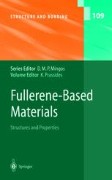Search
Search Results
-

-
Spin Crossover in Iron(II) Tris(diimine) and Bis(terimine) Systems
Tris(diimine) and bis(terimine) iron(II) complex salts constitute one of the major classes of spin crossover systems. Both electronic and structural...
-
Spin Crossover in Pyrazolylborate and Pyrazolylmethane Complexes
The electronic spin-state crossover observed upon cooling and at high-pressure in the iron(II) and cobalt(II) complexes formed with the HB(pz)3...
-
Surface Modification of Polyethylene
Polyolefins such as polyethylene, polypropylene and their copolymers have excellent bulk physical/chemical properties, are...
-
Angular momentum and spectral decomposition of ring currents: aromaticity and the annulene model
By a widely accepted criterion, an aromatic (anti-aromatic) π-conjugated system is one that sustains a global diatropic (paratropic) ring current...
-
Use of N,N-Coordinating Ligands in Catalytic Asymmetric C--C Bond Formations: Example of Cyclopropanation, Diels--Alder Reaction, Nucleophilic Allylic Substitution
Chiral N,N-coordinating ligands have been particularly synthesized for their use as metal chelates catalyzing asymmetric C-C bond formations....
-
Materials Chemistry of Group 13 Nitrides
The OMVPE process has been used to grow thin films of group 13 nitrides, namely GaN, InN, and AlN. In recent years there has been a great deal of...
-
Scanning Probe Microscopy Studies of Surface-Immobilised DNA/Oligonucleotide Molecules
Although most in vivo biomolecular recognition occurs in solution, in many practical situations (e.g., diagnostics, drug discovery and biosensing)...
-
New Phosphorylated Hosts for the Design of New Supramolecular Assemblies
Development of chemistry around new phosphorylated hosts provides an interesting new area of investigations in the design of host-guest systems....
-
Complexes with a Metal-Phosphorus Triple Bond
A survey of the existing complexes containing a transition metal-phosphorus triple bond is presented. Based on the different types of these...
-
Prediction of Crystal Structures Using Evolutionary Algorithms and Related Techniques
Methods, evolutionary and systematic search approaches, and applications of crystal structure prediction of closest-packed and framework materials...
-
Molecular Containers: Design Approaches and Applications
The design and synthesis of molecular containers is playing an increasing role in the selective removal and detection of species within solution. The...
-

-
Effects of acetylation on thermodynamic properties of seaweed alginate in sodium chloride solutions
Alginates are polysaccharides consisting of mannuronate and guluronate units. While bacterial alginate is acetylated, seaweed alginate does not...
-
Structural and Electronic Properties of Selected Fulleride Salts
The study of strongly correlated electron systems is at the forefront of contemporary condensed matter research because such materials, which include...
-
Thermal Spin Crossover in Mn(II), Mn(III), Cr(II) and Co(III) Coordination Compounds
This chapter considers thermal spin crossover occurring in transition metal compounds other than those of Fe(II), Fe(III) and Co(II). Unusual...
-
Isokinetic and Isoequilibrium Relationships in Spin Crossover Systems
A thorough statistical mechanical analysis of sources of variations and correlations in ΔE 0 and ΔS 0 of spin crossover...
-
Towards Spin Crossover Applications
In this chapter we attempt to review the potential for the application of the spin crossover (SCO) phenomenon in various domains, such as molecular...
-
Triplet Emitters for OLED Applications. Mechanisms of Exciton Trap** and Control of Emission Properties
Triplet emitter materials present attractive possibilities for optimizations of organic/organometallic light emitting diodes (OLEDs). This is due to...
-
Hydrogen-Bond-Mediated Template Synthesis of Rotaxanes, Catenanes, and Knotanes
The synthesis of rotaxanes, catenanes, and trefoil knotanes can only be efficiently accomplished, when a suitable template effect is used that...
